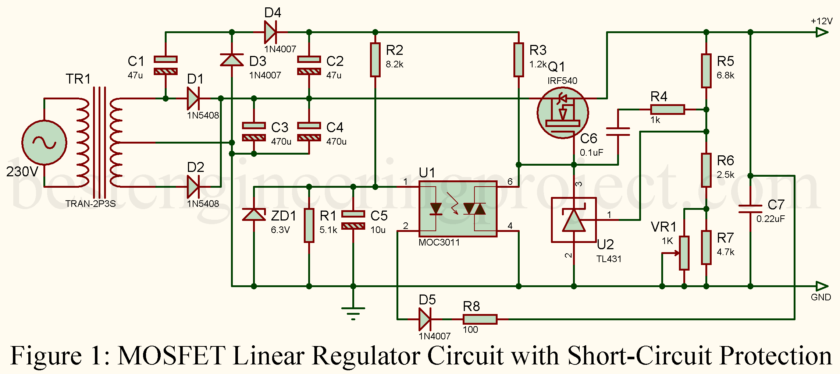Ever tried building a stable power supply only to find it wastes a ton of power in the form of heat? That’s where this MOSFET-based ultra-low dropout linear voltage regulator comes in handy. This design keeps power losses to a minimum, making it a great choice when you need an efficient, stable 12V output. Plus, it has built-in short-circuit protection, so it’s safe to use in demanding environments. Let’s dive into the details!
Why Choose a MOSFET for Ultra-Low Dropout?
Traditional regulators can drop quite a bit of voltage, which isn’t ideal if you’re working with limited input power. By using a MOSFET with low RDSon resistance, this circuit can achieve a super low voltage drop — around 60 mV at 1 amp! And if you need even lower dropout, you could pick an even better MOSFET for the job.
Main Components
Below is an overview of the components that give this regulator its functionality:
- IRF540 MOSFET (Q1): Star of the show in keeping the voltage drop low.
- TL431 Adjustable Shunt Regulator (U2): An error amplifier, providing stable output.
- MOC3011 Opto-Triac (U1): Used for short-circuit protection.
- Diodes (D1-D5): For the rectification and voltage doubling stages in addition to the protection stages.
- Capacitors (C1-C6): Filtering and stabilizing the output.
- Resistors (R1, R2, R4): These set current and voltage levels in the circuit.
- Trimpot VR1: This allows fine-tuning of the output voltage.
How It Works: Ultra-Low Dropout Regulator Circuit
Step 1: AC to DC Conversion
We use a 15V-0-15V step-down transformer first of all to step down the high-voltage AC. Then AC is converted into DC by diodes D1 and D2 and initial ripples are smoothed by capacitors C3 and C4.
Step 2: Voltage Doubling for the MOSFET Gate
In order for the IRF540 MOSFET to fully turn on, the gate voltage needs to be at least about 10V above the source. For that higher voltage, we use a voltage doubler circuit made out of D3, D4, C1 and C2. This boosted voltage, in turn, feeds into the gate of the MOSFET, through resistor R3, and allows it to conduct efficiently and hence minimize the voltage drop.
Step 3: TL431 Output Regulation
TL431 acts as an error amplifier, U2. The stage continuously senses the output voltage to make the correction by sending the gate voltage to the MOSFET so that it remains steady at 12V. Capacitor C6 and resistor R4 achieve stabilization of this feedback so that the operation is smooth and oscillations do not develop.
Step 4: Setting Output Voltage
Trimpot VR1 provides the output voltage adjustment. This trimpot will enable you to set a voltage to the exact needs that you are testing and will thus fine-tune the whole circuit to meet your needs.
Step 5: Short-Circuit Protection (Crow-Bar Protection)
The crow-bar protection circuit is a great safety feature. Here’s how it works:
- Under normal conditions, capacitor C5 maintains a stable 6.3V, keeping diode D5 off (reverse-biased).
- If the output is shorted, the voltage drops, causing D5 to conduct. This triggers the opto-triac MOC3011 (U1), which pulls the MOSFET gate to ground, shutting off the current.
- Once the crow-bar protection is triggered, it stays latched until you reset the circuit by switching the input power off and back on.
Tips for Building This Circuit
- Heatsinking: The IRF540 can handle up to 3A but does generate heat, so attach a heatsink to prevent it from overheating.
- Component Quality: High-quality capacitors (especially low ESR types) and precise resistors will make the circuit more reliable.
- Safety First: The transformer and high-voltage components need to be handled carefully. Make sure everything is rated for the input AC voltage to avoid risks.
Where This Circuit is Useful
This ultra-low dropout MOSFET regulator is perfect for applications that need:
- 12V output with minimum loss in voltage.
- High current handling, up to 3A with proper heatsinking:.
- Inbuilt short-circuit protection to prevent component failure.
Final Thoughts
This ultra-low dropout linear regulator circuit with a powerhouse MOSFET is ideal in efficiently providing power delivery along with minimizing heat loss, along with great short-circuit protection. The combination of the IRF540 MOSFET, TL431 error amplifier, and crow-bar safety mechanism makes this a solid choice for powering sensitive electronics or high-current loads. Whether you’re working on a DIY project or a professional application, this design provides reliable and efficient power regulation.

IS IT CAN USED FOR BATTERY CHSRGING SYSTEM?
This article is primarily designed as a voltage regulator to maintain a stable output voltage with minimal dropout, even under varying loads. While it offers features like short-circuit protection, it is generally not ideal for battery charging.